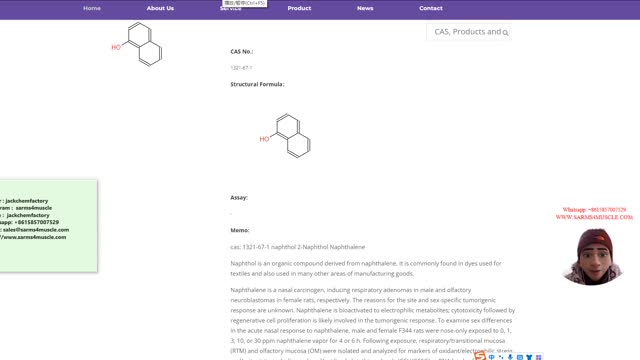Premium Only Content

cas: 1321-67-1 naphthol 2-Naphthol Naphthalene
cas: 1321-67-1 naphthol 2-Naphthol Naphthalene
Naphthol is an organic compound derived from naphthalene. It is commonly found in dyes used for textiles and also used in many other areas of manufacturing goods.
Naphthalene is a nasal carcinogen, inducing respiratory adenomas in male and olfactory neuroblastomas in female rats, respectively. The reasons for the site and sex-specific tumorigenic response are unknown. Naphthalene is bioactivated to electrophilic metabolites; cytotoxicity followed by regenerative cell proliferation is likely involved in the tumorigenic response. To examine sex differences in the acute nasal response to naphthalene, male and female F344 rats were nose-only exposed to 0, 1, 3, 10, or 30 ppm naphthalene vapor for 4 or 6 h. Following exposure, respiratory/transitional mucosa (RTM) and olfactory mucosa (OM) were isolated and analyzed for markers of oxidant/electrophilic stress and/or toxicity, including reduced/oxidized glutathione levels (GSH/GSSG), mRNA levels of electrophile-responsive genes, and epithelial cytoxicity (as measured by membrane permeability to ethidium homodimer-1). Naphthalene caused significant depletion of GSH in RTM and OM with no increase in GSSG. Cytotoxicity was apparent at concentrations of 15 and 30 ppm. No consistent sex differences were observed in these responses. Sex differences were observed in the induction of antielectrophilic genes in OM: glutamyl cysteine ligase (catalytic subunit) (Gclc), NADPH quinone oxidase 1 (Nqo1), and heme oxygenase 1 (Hmox1) were all induced to a greater extent in the male OM compared with the female. No consistent sex differences were observed in the RTM. Although the mechanism of the sex difference in the RTM adenoma response remains enigmatic, sex differences in the induction of antioxidant/electrophile-responsive genes may contribute to the heightened sensitivity of the female OM to the carcinogenic effects of naphthalene.
-
 8:04
8:04
MattMorseTV
7 hours ago $2.77 earnedTrump just DROPPED a BOMBSHELL on California.
22.7K25 -
 46:10
46:10
Friday Beers
8 hours ago $0.30 earnedSkeletons, Cults, & Ex-Girlfriends Terrorize Our DND Campaign
15K -

megimu32
2 hours agoON THE SUBJECT: STOP REMAKING CLASSICS — Hollywood Is Out of Ideas!
24.1K4 -
 1:16:43
1:16:43
Precision Rifle Network
1 day agoS4E19 Guns & Grub - Let's Talk About Wind
11.5K -
 LIVE
LIVE
SoundBoardLord
3 hours agoThriller Thursday! Is Simon There? TERRIFYING!
70 watching -
 LIVE
LIVE
FomoTV
1 hour ago🔥 ICE Protests Erupt, Israel Strikes Iran, Missiles Launched – Global Flashpoints LIVE 🚨 | FOMOCAST 06.12.25
160 watching -
 LIVE
LIVE
Spartan
5 hours agoPro Halo Player | Halo Infinite Ranked Arena into SWTOR
85 watching -
 1:33:56
1:33:56
Mally_Mouse
3 hours agoLet's Play!! -- 60 Seconds! -- I'm nervous..
7.34K2 -
 1:28:23
1:28:23
Glenn Greenwald
6 hours agoIsrael/Iran Escalation: WW3 or Negotiating Tactic? Plus: Analyst Curt Mills on Trump's Israel/Iran Policy and More | SYSTEM UPDATE #467
75.2K60 -
 LIVE
LIVE
STGKAMZZ
3 hours agoWARZONE WIT THE SQUAD 4REAL 4LYFE
15 watching